Chris Baty's Blog, page 32
November 2, 2021
Author Interview: Writing and Publishing Tips from Emily Shore

Every year, we’re lucky to have great sponsors for our nonprofit events. Kindle Vella, a 2021 NaNoWriMo sponsor, is a new way to tell a story, one episode at a time. Today, Emily Shore, a Top Faved Kindle Vella author, shares some writing and publishing tips:
Author Emily Shore met with Kindle Direct Publishing (KDP) and shared how she stays motivated when writing, along with tips about her writing and publishing processes. Emily started publishing The Uncaged Series with KDP in 2019 and in June 2021 found success publishing on Kindle Vella with the Bride of the Corpse King. Since June she regularly publishes episodes of Bride of the Corpse King which is a Top Faved Kindle Vella story.
Q: Hi, Emily! First things first, could you tell us a little about yourself and what genre you usually write?
A: I’m a cult survivor, a proud bisexual feminist, and my work is #1 in the Kindle Vella “Fantasy Romance” category out of 10,000 authors. My goal is to entertain and empower by featuring queer casts in my books. I’m currently building my publishing options through Kindle Vella as a Top Ten author for my Bride of the Corpse King: A Hades and Persephone Retelling fantasy romance. I am also a Top 100 Kindle Author of the YA anti-trafficking dystopian: The Uncaged Series. For the past decade, I’ve trained with international and local anti-trafficking organizations and worked as an awareness speaker all over Minnesota: churches, youth and retreat centers, and conferences attended by thousands of educators and librarians. My passion is to celebrate queer and empower female audiences, including my two daughters.
Q: What is your typical writing process (although most writing processes are far from typical!)?
A: To be honest, I just sit down and do it. I’m a locomotive, and I am able to write 3,000–10,000 words in one sitting depending on my time and health issues. Then, I do a quick-and-dirty edit, a silent line-by-line edit, then I read my work out loud line-by-line to catch any errors. Finally, another quick-and-dirty edit to eliminate any filler words.
Q: You have paperback/hardcover, eBooks, and have recently starting publishing with Kindle Vella. Do you have any advice for authors looking to expand their publishing portfolio? How does the process differ between the three publishing options?
A: I have found a wonderful home with Kindle Vella for my Bride of the Corpse King: A Hades and Persephone Retelling. It requires a great amount of marketing, grassroots movement, building a loyal readership, offering giveaways and fun content, and most of all: time. It has required much hard work to balance writing consistent serialized content while juggling blogging and marketing on social media. I have done this under extremely stressful health circumstances, but I choose to believe my writing and my books are worthy of their place leading in multiple Vella categories. I also love the writing community there and have made friends with top-five author E.H. Blackwell, an indie bestie. I love Kindle Vella, which is supplementing our family’s cancer medical bills and gifting me a silver lining during my extreme health issues.
Q: How do you stay inspired?
A: Everything inspires me. This is my career. But it’s also been my dream since I was a budding author. It’s my passion. It’s who I am and what I do. A forever writer, I was born with an author’s heart and soul! I have a message, I have a voice, and that makes me worthy to share!
Q: If you could go back and tell your pre-published self one thing about the writing and publishing process, what would it be?
A: Channeling Dory from Finding Nemo: Just keep writing, just keep writing…Seriously, don’t listen to the haters. Growth will come. Resistance will come. But breakthroughs will also come. Despite how literary agents will hurt you, you will overcome and learn from trial and error. I am proud of you. I know you will never quit!
To find out more about Emily’s work, newsletter, and monthly giveaways, visit: www.emilybethshore.com.
To find out more about publishing on Kindle Direct Publishing visit: kdp.amazon.com
To find out more about publishing on Kindle Vella visit: https://www.amazon.com/kdp-kindle-vella/b?ie=UTF8&node=21613975011
November 1, 2021
30 Covers, 30 Days
2021: Day 1
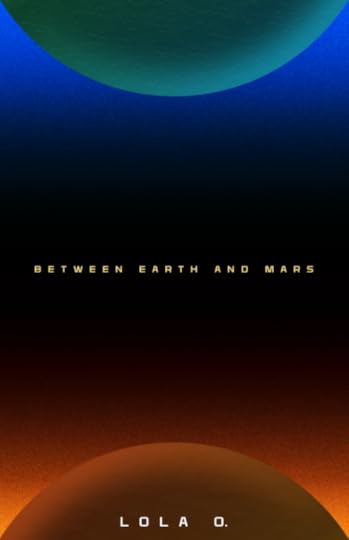
It’s official, it’s the first day of 30 Covers, 30 Days! We already have an amazing Sci-Fi novel by our YWP participant Lola O. This cover was designed by an awesome, returning artist Joe Schwartz.
(For those of you who don’t know, 30C30D stands for 30 Covers, 30 Days in which 23 Wrimos and 7 YWP Participants get the chance to win a professionally designed cover! We’ll be posting a cover a day throughout November, so make sure to check them out!)
Between Earth and MarsBoth time and the universe itself have strange links. Links, such as that of a girl on a colony on Mars and a boy living on Earth in his family’s farm. Detached from society being seemingly the only connection, the drastic differences in their lives apparent, the question remains: How much do we really change?
Lola is an avid reader and writer, who has recently discovered NaNoWriMo while looking for writing contests and programs. She also is involved in NSDA Speech and Debate, as well as a founding member of her school’s UNA Club Chapter. When she is not writing for YWP/Nano, she can be found outside in the desert heat, watching her dog run around barking at everything that moves, or inside watching comedy shows and adding on to her LEGO creations.
About the ArtistJoe Schwartz is pleased to be invited back to design his fifth NaNoWriMo book cover. The process of making is Joe’s “happy place”, but when he’s not making work he is a design instructor at Spotswood High School and an adjunct professor at Kean University’s Michael Graves College, both in New Jersey. He is also the co-founder of DESIGN-ED, an education nonprofit that helps teachers and students use design as a tool for teaching and learning.
A small portfolio of Joe’s work (including past NaNoWriMo covers) can be found at: www.schwartzdesign.biz
October 28, 2021
Why Novlr is the Perfect NaNoWriMo Writing Companion

Every year, we’re lucky to have great sponsors for our nonprofit events. Novlr, a 2021 NaNoWriMo sponsor, is the smart writers’ choice for novel writing software. Today, writer, editor, researcher, and professional historian Pamela Koehne-Drube shares why she uses Novlr as her writing platform:
Writing is a deeply personal experience, but every year, during NaNoWriMo, it’s the sense of community that brings us all together. Knowing that other writers all over the world are committing to get a head start on their novels is an amazing feeling, and setting goals and targets every day for a month is just the push that so many of us need to finally get words on a page.
National Novel Writing Month is a huge part of Novlr’s history. The idea for it was born when Thomas, one of Novlr’s founders, participated in NaNoWriMo and realized that there just wasn’t a novel-writing software out there that truly catered to novelists. With a lack of appropriate options available, the only thing left to do was to create one, and thus, Novlr was born.
There is no better way to experience NaNoWriMo than through Novlr—it really is the perfect writing companion. As a NaNo participant since 2014, I’ve had the chance to participate for a few years now with Novlr, and it’s got me over the finish line on more than one occasion. Having the right space to write really does make such a difference.
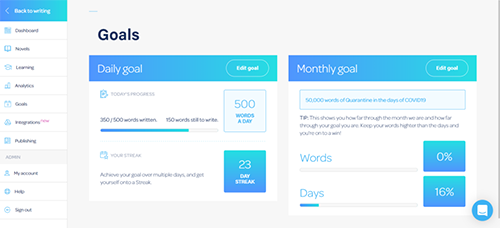
Novlr allows me to set my goals year-round and logs my writing streaks.
One of the biggest barriers I’ve had to my writing is goal setting and goal tracking. It’s one of the reasons I was drawn to NaNoWriMo in the first place. Forcing myself to dedicate time to writing around a busy schedule helped my productivity. I tried so many options for my first few NaNo years, but I found that other options were either a) uninspiring, or b) so complicated that I spent more time actually using the software than doing any writing. I needed something that was distraction-free but also pushed me to get words on the page.
What first struck me about Novlr was its minimalist aesthetic and professional design. It is simple, easy to use, and yet deceptively powerful. No matter how cluttered my physical space gets, Novlr is always there, clean and stress-free, ready to come with me wherever I need it.
The app itself is browser-based, meaning no matter where I am, or on what device, I’ll always have an up-to-date version of my work accessible to me any time—even on my phone. It means that when inspiration strikes, I can have my novel up and running, ready to go in a matter of seconds with cloud saving, backups, and versioning so I can be sure I’ll never accidentally overwrite something. It also means that I can switch up my workspace and go wherever I feel inspired—it’s like a pool of portable calm. I can be in the right space for writing both mentally and physically, and there’s nothing more than a writer could hope for.
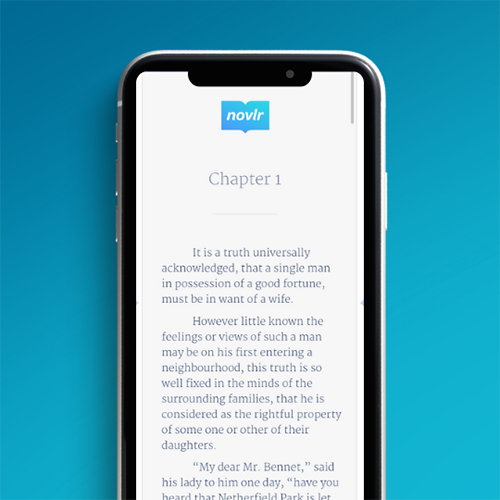
Let’s not beat around the bush—writing 1667 words a day is HARD! Because of that, having the best tools at your disposal is absolutely invaluable. There are loads of Novlr features that make it the right tool for the job. Distraction-free writing and goal tracking are just the tip of the iceberg.
If I’m short on inspiration, the Tim Clare Couch to 80k writing course is integrated directly into the platform. If I need to kickstart my creativity, a writing prompt or character exploration is never more than a click away. In fact, for 2019’s NaNoWriMo I didn’t have a project, so I set myself the goal of coming up with a new novel idea over the course of the month using Tim Clare’s course. I absolutely smashed my 50k goal and ended up with a workable novel draft that I used as the basis for a ghostwriting project early in 2020.
I think why Novlr really makes the perfect NaNoWriMo companion though, is that everyone who works on it is a writer, and cares about what writers need. They actively work on features that writers want and avoid bloat with features they don’t. And because of their NaNoWriMo integration, Novlr also has a front-row seat to how their users perform over the National Novel Writing Month and can tailor their platform accordingly.
Very few NaNo participants manage 30 days of non-stop writing. Life gets in the way, so it’s easy to lose focus. With streaks built into Novlr’s platform, it helps form writing habits, and with word count goals that give pop-ups that cheer you on the closer you get, and applaud you when you reach them, it makes writing feel like a joyous experience rather than a chore. There’s a sense of accomplishment when you reach your goals or embark on a writing streak. It’s that attention to detail and the little things that can make all the difference to your writing routine.
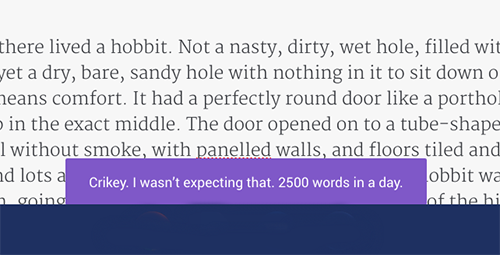
Novlr gives me encouragement as I reach key writing milestones.
Over the years, Novlr has grown into something truly special, and now, with full NaNoWriMo integration, it’s never been easier to track my word count and be a productive writer. If all goes well over NaNoWriMo I can even publish to eBook, straight from the dashboard. And because it allows me to set my own goals outside of November, I can keep the NaNo spirit going all year round!
Novlr is offering NaNoWriMo 2021 participants 40% off for a year with the coupon code NANO2140. Extend your discount to 2 years by winning NaNoWriMo 2021! Offer expires December 31, 2021.

Pamela Koehne-Drube is freelance writer, editor, researcher, and professional historian who has just joined the Novlr team. As a ghostwriter she has published both fiction and non-fiction books over a variety of subjects and genres for self-published writers and for major publishing houses. Pamela lives in West Wales with her husband and a little tornado of a Staffordshire Bull Terrier. The rugged beauty of the Pembrokeshire coast inspires her every day.
October 27, 2021
I Published My NaNo-Novel: A Young Writer’s Story
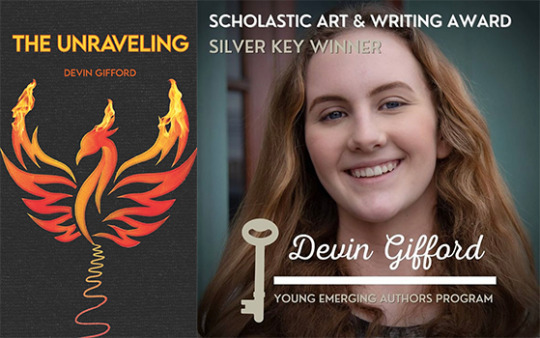
While NaNoWriMo’s Young Writers Program encourages kids and teens ages 18 and under to write their own novels, other nonprofits like The Telling Room help publish them. Today, young author Devin Gifford shares her story of writing and publishing her NaNoWriMo novel.
As NaNoWriMo approaches, I want to share my story with my fellow young writers who have participated in the challenge of writing as many words as you can in a single month. Whether that number was 1,000 or 50,000, consistently finding time to put the metaphorical pen to the page is an achievement all in itself.
My writing and I have a somewhat inconsistent, love-hate relationship, as I think many writers would say. But throughout this tumultuous relationship, NaNoWriMo has helped me return to writing time and time again. I wrote and self-published my first two books through the junior program, the first when I was in third grade and the other in fifth grade. (Both are available on Amazon, though I’ll admit they are not necessarily my best work.) In fifth grade, I began drafting the jumbled mess of a science fiction story that would eventually become The Unraveling.
In November of that year, I participated in NaNoWriMo and set my word count goal for 25,000, half of the true NaNoWriMo word count. I did meet that goal for November, but I set my unfinished draft aside afterwards and abandoned it during sixth grade. I did not participate in NaNoWriMo when November rolled around. In seventh grade, I made my triumphant return. I read over my year-old writing and cringed repeatedly, yet I still decided that the draft was worth finishing. November came, and I met another ambitious word count goal and completed the draft by December. NaNoWriMo was the tool that helped me meet my writing goals and inspired me to finish my story.
Unfortunately, I read my draft over and essentially decided that it was a dumpster fire. It was a mix of my fifth and seventh grade writing: two different halves of the same story. Honestly, much of the plot didn’t make any sense, but the basic idea was there. The monsters in the fog, the post-apocalyptic setting, some of my characters. It held the essence of what would become my first full-length published novel. I didn’t see that at the time, so I hid it away for all of eighth grade. I missed another NaNoWriMo season.
In the summer before freshman year, I heard about the Young Emerging Authors program at the Telling Room in Portland, Maine. I was already rewriting my first draft and attempting to revive my story, and my mom encouraged me to submit some of my rewriting to the program. I expected absolutely nothing to come of my submission. In my mind, my writing was for nobody but me, and nobody else would consider it to be any good. To my complete shock and horror, I was accepted to the program that year, alongside three other high school authors.
The program is designed to support four young authors as they publish their novels in a single year. I had only ten pages of my second draft when I submitted, so for me, the process began with drafting. And drafting. And drafting. That November, I once again turned to NaNoWriMo. For the first time, I committed to completing the full NaNoWriMo challenge: 50,000 words in one month. And somehow, after those thirty days were up, I had done it. Those words, that I wrote hurriedly at midnight or in the earliest hours of the morning, whenever I could find the time, ended up producing some of my favorite scenes in my published novel. I am incredibly proud of myself for sticking to the challenge and emerging victorious, not to mention the progress that I was able to make on my draft in a single month.
I ended up completing my draft sometime in January, and then came revisions. The Young Emerging Authors program provides each fellow with their own mentor, an experienced published author, to guide them through the revision process. My mentor and I sorted through the good and the bad of my draft and figured out what the actual plot of my book was supposed to be. It was one of the most stressful and rewarding parts of the program. Afterwards, a second reader read my story to point out what still didn’t make sense, and my copy editor made tons of little edits. By spring, my manuscript was nearly finalized. After I’d finished agonizing over a title, I taught myself to use Photoshop in a single night and helped to design my own cover.
Summer came, and we printed proofs of our novels. We were able to physically hold the result of our year-long struggle, and it was all worth it. The book launch was unfortunately virtual, but it was still a celebration of all that we had accomplished in such a short time. I left the program with a shiny new novel, lasting friends, and a sense of confidence in myself and my writing that I never had before.
Young writers tend to lack confidence in their writing, as I certainly did and sometimes still do. It seems daunting to share such a personal piece of yourself with someone else, and the fear of criticism is often enough to make you hide your writing away. So I want to leave you with this: don’t hide. Share your voice and your writing with the world. Be open and accepting to the feedback you receive. You’ll find that it will only make you a better storyteller. Above all, don’t stop writing. Even if you stray from the path, as I have and likely will again, find your way back. Keep telling your story. It will be worth it.
Best of luck,
Devin
The Telling Room is a Maine-based literary arts education nonprofit whose mission is to empower youth through writing and share their voices with the world. Focused on young writers ages 6 to 18, its ten different writing and publishing programs seek to build confidence, strengthen literacy skills, and provide real audiences for student writing. Young Emerging Authors is a free, year-long afterschool writing and publishing program in which four Maine writers in grades 8 through 12 are selected to write, revise, and publish their own books in an intensive writing group alongside seasoned mentors. You can buy Devin’s book, The Unraveling, at The Telling Room’s online store.
Devin Gifford lives in North Yarmouth, Maine, and attends Greely High School. She has two dogs and an ornery cat. She spends most of her time writing and reading, as well as brainstorming for a sequel to her most recent novel. She’s been an inconsistent participant in National Novel Writing Month since her very first writing endeavor in third grade. In her free time, she likes making art and making up stories.
October 26, 2021
Five Tips for Finishing Your Novel with Kobo Writing Life
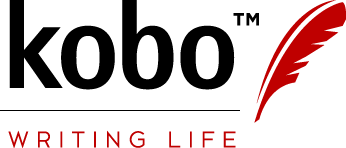
Every year, we’re lucky to have great sponsors for our nonprofit events. Kobo, a 2021 NaNoWriMo sponsor, is a thriving author community. Today, writer and podcaster Joni Di Placido shares some tips on how to finish your novel:
Kobo stands for books.
In our little corner of downtown Toronto, we are a team of very passionate booklovers who spend our days talking about our favorite books and audiobooks, the best new eReader features, and how to make reading lives better for our customers.
Our independent publishing community, Kobo Writing Life (or KWL), is home to thousands of authors who publish directly to Kobo using our simple, author-friendly platform. Here at KWL, we’ve helped thousands of writers become published authors and share their stories with the world. We’ve spoken with hundreds of those authors over the years on our podcast, and we’ve gathered some of our favorite writing tips for anyone embarking on NaNoWriMo this year!
1. Show, don’t tell, when writing emotion.We know; it’s a well-worn cliché. But what does it really mean, and how do we do it? Author Sacha Black described it beautifully when she spoke to us about writing. She explained the importance of including all the little details that make a reader feel emotional.
For example, when writing about a character’s death; it’s not the fact of the death itself that makes us sad; it’s the little things that are gone with them. It’s the way a character’s partner would bring them coffee in the morning, or the way their parent looked at them when they were proud, or a thousand other tiny details that are unique, and yet universal, that we can all relate to. It’s not enough to tell your readers that a character is happy, or heartbroken, or relieved – think about how you can show those emotions through their behavior.
2. Tell a story through fashion.A more literal interpretation of Show, Don’t Tell! When we spoke with author and stylist Heather Newberger, she explained that fashion can help to convey a character’s story. Make sure you know how your character presents themself to the outside world. Use a mood board to visualize your characters’ style, and the clothing choices they make; think about what different colors convey in clothing.
3. Consider using sensitivity readers to create three-dimensional characters.Paul Ardoin, whose first published novel started as a NaNoWriMo project, felt that it was important to challenge himself by writing about characters with different experiences to his own. You don’t always have to write what you know, but make sure you do your research to learn about how to write characters with different lived experience, and how to avoid tired stereotypes. If you’re not sure if your writing hits the mark, consider hiring a sensitivity reader to help you elevate your writing!
4. Find the writing process that works for you.We talk a lot about plotters and pantsers in the writing world. Writers typically self-identify as plotters, who plan out everything they write, or pantsers, who “fly by the seat of their pants” and figure out the plot as they go. When it comes to preparing for NaNoWriMo, most writers seem to agree that plotting is the way to go—that having an idea of what to write helps make the task of 1666 daily words more manageable. But if we’ve learned anything from our KWL author community, it’s that there is no single right way to do anything.
We loved learning about author Steff Green’s process of “Skeleton Drafting”, in which she starts by “pantsing” her way through a rapid first draft, creating a skeleton of a story by roughly shaping each chapter’s dialogue and action. By the time she’s finished, she has a very rough draft, and a solid plot, and she can then go back and fill out the “meat” of the story. She’s written about her process here; if you find yourself stuck, it might be the perfect time to try a new way of planning!
5. Know what you’re going to write tomorrow.When you’re a full-time writer, you can’t sit around and wait for inspiration to come to you; you have to keep putting those words on the page. With NaNoWriMo, the challenge is to keep hitting that daily count for 30 days, and keep the momentum going. Author Michael Polelle shared a tip from Hemingway that helps him to counter writer’s block. He told us that every day he stops writing before he’s finished the segment he’s working on. That way when he opens his computer the next morning, he can pick up where he left off and finish what he started the previous day. He told us that really eliminates any sense of writer’s block and helps to maintain the momentum of a story. It may be hard to step away from the manuscript when you’re in the zone, but you’ll thank yourself when you slide right back into the story the following day!
We hope to see your books one day on Kobo Writing Life! If you’re ready to start your publishing journey, create an account on kobo.com/writinglife and join our indie author community. You can also follow us on social media, subscribe to our podcast on your favorite streaming platform, and contact us directly at writinglife@kobo.com.

Joni Di Placido co-hosts the Kobo Writing Life podcast and works on the business team of KWL, working directly with indie authors to help them sell eBooks and audiobooks worldwide. She loves to read and is hoping to “win” NaNoWriMo for the first time this year!
October 25, 2021
Internal Conflict: Connecting With Your Characters

Every book has a character or two, but how much do they matter to your story? NaNo guest Avery Nicole explains that characters who have inner conflict make the story memorable.
What makes a book addictive? What makes it so hard to put down?
The answer is the characters.
You may be thinking, no, it’s the plot. The exciting, adventure-packed stories are the best… But what would the plot be without your characters? They are the ones driving your story, the ones pushing against the plot and making the story stretch to its end.
There are always characters. There isn’t just a plot, it isn’t just a documentation of what happened, it’s a story of whom it happened to.
Why is it that in some stories, we find ourselves connecting with the characters, but in others, we are unable to relate? Maybe because so many books do not contain the secret ingredient: internal conflict. Your character’s lie-driven motive pushes against the reality of the situation.
Let me explain.
People are broken and imperfect. We all believe lies about the world, and every day these false beliefs control our actions and words. Someday, though, we might come to the conclusion that what we always believed was false. This is what makes a good story because any person on the face of this planet can relate to it. We all get things wrong, we all have false beliefs that someday we might come to the other side of.
A story isn’t simply a plot, but a character arc, a revelation. A journey from Point A (the lie) to Point B (the truth). Examples of lies? I have to be famous and popular. I have to be perfect. I have to prove myself. By the end of the story, the character has come to see the opposite of this. I don’t need money or fame, I need to love and be loved. I don’t need to be perfect, everyone is flawed and that’s okay. I don’t need to prove myself, I need to be myself.
The opposite of this lie is your story’s truth. Your story’s theme. It’s that motivational quote or idea that you want to tell the world, it’s why the story matters so much to you. It’s what will bring you to 50,000 words in thirty days.
See, this is where so many authors have gotten confused. So many writers don’t connect with their characters.
You could walk away from this blog post shaking your head, and that’s okay. This isn’t the only way to write, it’s just my advice. But you could also walk away from this blog post smiling, finally realizing what your story might have been missing all along.
Violence and plot and war and grief aren’t what captivate readers. It’s why that violence and plot and war and grief matter specifically to your character.
So it isn’t the plot. It’s the characters. Their lies, their truths, their internal conflict. The characters are what make you want to read past your bedtime. They are what make the book so meaningful. They are what will bring you to your goal of finishing your novel.
Avery Nicole is currently a sophomore in high school, on the road to college. When she was seven she wrote her first short story and writing has rarely left her mind since. In her free time, she enjoys writing contemporary novels and poetry. She continuously works to achieve her goal and dream of publication.

October 22, 2021
How to Self-Edit Without Being Overwhelmed

How many times has self-editing distracted or made a mess in your drafts? It happens to the best of us. NaNo guest Elzevera has prepared a guide to help you conquer your self-editing tendencies and do it in a more productive, efficient way.
If you consider self-editing a necessary evil you need to get over with as quickly as possible, you are not alone. Most writers heave in despair at the thought. Not to mention the crippling fear of not being good enough.
But self-editing can be an empowering experience that leaves you bursting with pride instead of wallowing in the darkest corner of your mind.
No idea how? That’s what I’m here for.
Once you master the elements of BLOT, you’ll be self-editing effectively and efficiently—with confidence—in no time.
BLOT – Break & BreatheThe first step that will make a major difference to your self-editing experience is to take breaks. Many, lengthy breaks. And here’s where the second part comes in: breathe. Know that it’s okay to take your time and to adjust self-imposed deadlines.
Many writers fight me on this step because they’re afraid of losing touch with their manuscript and of taking too long to get to the finish line.
But you know what? Losing touch with your writing is the goal here. By stepping away from your book for a few weeks—a month is ideal—you ‘forget’ what you’ve written.
This makes it easier to consider your manuscript from a fresh perspective: you’ll spot things to improve straight away. You’ll also be surprised by how good some passages already are.
BLOT - Learn & PrepareA common mistake I see writers make when self-editing is diving in without a plan. When you wing it and read your manuscript over and over, just hoping to come across elements you can improve, several things happen:
The process gets real tedious real fast. When you repeat the same step again and again because you feel you have to, your energy will go down the drain. You miss important things. Because you’re looking for everything at the same time–while not understanding what you’re really looking for–you get pulled into specific passages and ignore others.There’s no indication of how far along you are in the process, which can cause despair and hopelessness.Luckily, there’s a simple solution to avoid all the above: educate yourself before you start. Find a framework to follow and know exactly what to look for in which round. This can reassure you that you will get to the end.
BLOT - One thing at a timeThis step ties into the previous one: when you attempt to edit everything at once, you end up exhausted and frustrated. And you’ll miss a huge number of things you could have easily tackled with a one-by-one approach.
Some writers feel they should be able to do it all at once because they believe that’s how professional editors work as well.
First: self-editing is not the same as professional editing. The goal of self-editing is to make your manuscript as good as you can make it with the tools and skills you have at your disposal.
Second: when I was an editing intern at a children’s book publisher, it was the In-House Editor who kept reminding me to focus on one thing at a time. And it’s made a world of difference to how much I can improve in any piece of writing.
BLOT – Time is your friendYou may feel you need to get your novel published as soon as possible. With the entire internet shouting, you should write more and faster and daily social media posts from fellow writers who just published their book, that’s not surprising.
What no one tells you is what I’ve seen many times: when writers rush to publication, 99% of the time, they’re unhappy with the quality of their writing.
There’s the initial rush of hitting publish, but the pride fades away and is replaced by self-doubt and more negative feelings revolving around ‘why am I not good enough?’
I’m here to tell you that you are good enough. You will experience the thrill of launching your book AND the pride that comes with publishing a book you nurtured as much as possible by taking your time.
If you have questions about BLOT or self-editing, message me on Instagram @willowediting or email me at elzevera@willowediting.com.
Are you ready to BLOT your way through the self-editing process once NaNoWriMo is over, during Camp NaNoWriMo, or as a NaNoWriMo rebel? Download my free Self-Editing Checklist here for support.
Elzevera is a self-editing coach on a mission to help fiction writers self-edit effectively and efficiently so they can self-publish without regrets. She loves to read and write fantasy, and has a soft spot for talking animal characters. She lives in the Netherlands with her husband and baby daughter, who cheer her on in the background.

Top Photo by Faye Cornish on Unsplash
October 19, 2021
Getting Started and Keeping Going with NaNoWriMo

Every year, we’re lucky to have great sponsors for our nonprofit events. Inkstacks, a 2021 NaNoWriMo sponsor, is a project-based platform and award-winning book featuring a Guided Path for writers. Today, long-time Wrimo and Inkstacks CEO Kimberly Cooper Griffin is here to share some tips for getting started with your novel:
Hello, fellow NaNoWriMo Writers!
This year marks my 10th anniversary of being a NaNoWriMo participant and previous winner. What a journey it has been. I started as an aspiring writer, and now I’m a published author with eight titles available and five others in the pipeline. And it all started with NaNoWriMo!
As most participants do, I started on Day One with an idea and the motivation to complete 50K words in 30 days, and with the wonderful encouragement provided by the team at NaNoWriMo, I did it. I slammed down all those words and then some. It was a thrilling experience and it proved to me I could do it—and I’ve done it multiple times since.
Looking back on that first year in 2011, the first thing that comes to mind is how much I’ve learned in the last ten years, and I wonder what I would have done differently knowing what I know now.
It came down to planning, which would have gotten me off to a stronger start; and transforming, because I didn’t know what to do with my beautiful new manuscript once I came down off of my NaNoWriMo winner’s high. Believe me, the high I had when I hit 50K was intense! As you can see, I’m still NaNoWriMo-ing 10 years later and I have no intention of breaking this particular addiction.
There you have it, my writer friends. I want to talk to you about:
Getting started and keeping goingIt all comes down to planning and transformation.
PlanningA good foundation results in a strong story, and each of the elements of writing cobbled together creates a beautiful structure.
Taking time in the beginning to figure out a few key elements such as point of view, main plot points, and basic character aspects will not only help you get off to a strong start, it will help you power through the often difficult period in the middle when you’re trying to figure out what comes next.
Inkstacks has created eight simple worksheets to help any writer quickly set up the foundation of their project.
Go here to get your FREE WORKSHEETS and get a strong start on your NaNoWriMo project.
TransformingRewrites are where the magic happens.
For some writers, rewrites are the bane of their existence. They’ve written the story, and the last thing they want to do is write it again, and again, and…again. But, I’m here to tell you, it doesn’t have to be awful. In fact, rewrites are my favorite part of writing. I get to see the beauty and emotion of my words emerge and weave together to make a good story into a more powerful and evocative story.
There’s a reason why the first ‘go through’ is called the ugly first draft. Like an artist creating a work of art, there are layers to your masterpiece. In the beginning there is the first sketch, and then there’s the blocking, and finally comes the definition and details. Rewrites bring out the impact of the work, taking a great idea and making it brilliant. To me, there is no better accomplishment as a writer than to take a handful of common words and transform them into a meaningful and clever sentence that carries my voice and imagination beyond the confines of a page.
When you get to the end of your NaNoWriMo month and you have your winning 50K words, Inkstacks would be honored to help you transform your ugly first draft into the magical manuscript you want it to be.
Go here to get your Magical Rewrites Project.
Plus, all NaNoWriMo participants can receive 25% off all Inkslinger products by entering NANOWRIMO21 into the coupon code field in the Inkstacks webstore!
Your words are magic and the world needs your story.
Best of luck and early congratulations on making your dream come true.
With writerly love,
Kimberly Cooper Griffin
CEO Inkstacks – For Writers

Kimberly Cooper Griffin is a software engineer and an award-winning author. Her career in technology has spanned three decades, including work at several successful startups that have made it to the Fortune 500. With a breadth of experience that focuses on customer success, she has woven together her solutions-based mindset, technical aptitude, and a passion for writing to co-found Inkstacks.
October 18, 2021
When Writing Stops Being Fun

What do we do when writing feels more like a chore than an enjoyment? NaNo guest Alta Krige shares her wisdom on the importance of maintaining and resting when we experience that struggle.
The second hardest conversation I ever had to have, was telling someone “Sorry. I can’t do this at the moment. I am struggling with depression.” It sucked.
The hardest conversation I ever had to have, was to tell this to myself.
I love writing. I love the process of writing, not just ‘having written’. I love putting words on paper. I love telling stories and expressing ideas. I love the sound of pencil on paper and the rhythmic tap of typewriter keys.
Keeping a writing routine had always kept me grounded when my mental health was acting up. (I have bipolar disorder; it does act up sometimes.) It kept me going.
Journaling had helped me process, stories helped me escape, chronicling it gave me purpose. And just keeping the routine of it, helped me get up in the mornings.
Until it didn’t.
I tried so hard because writing was supposed to make it all better again, but instead, it became filled with anxiety. I had to talk myself through every line.
It’s okay, Alta. Just one word at a time, Alta. You can do this, Alta.
Only I couldn’t. Not this time.
Writing had stopped being fun. It had stopped helping. This time, trying to write was hurting me. What had been an anchor, became a dead weight, pulling me down, down, down.
I am a writer, and writers write. I felt like a failure for not writing.
Then something happened that gave me a bit of perspective. My cousin broke his knee.
He loves jogging, but at that moment, he could not even walk. If he had tried to walk, he would just have hurt himself further.
I was hurting myself, and I had to stop trying to run on a broken brain. Depression is not just about feeling negative emotions, it is problems within your physical brain. There are parts of your brain that shrinks - there are actually less grey matter! There can be inflammation in the brain, just as in my cousin’s wound.
Neurotransmitters, like serotonin, are the things that physically carry messages. Your brain can’t get messages through.
No wonder I couldn’t write. This wasn’t something to beat myself up about. Just because my cousin couldn’t run for a while, didn’t mean he was a failure as a runner. It just meant that then, at that moment, he couldn’t run. He still has the ability, the injury must just heal. It didn’t mean I couldn’t write or wasn’t a writer. It just meant I couldn’t write then, in that space of time. I had to give myself a chance to heal.
I had to tell myself that this is temporary. It will pass. I will be able to write again. But I also had to realize that, even if I am never able to write another word, I will be okay. I am enough, with or without writing.
More than a year after my cousin’s injury, he is jogging again cautiously. And I am writing again too. Cautiously. I have not attempted a novel again, yet. Maybe this year’s Nano is still too early. No marathon-sprints on recovering injuries. Some athletes had to miss the Olympics, after all. (Yes, in my metaphor, missing NaNoWriMo is the same as missing the Olympic games.)
But I am writing consistently. Blogs. Articles. Writing Prompts. I am starting to brainstorm a children’s story. (Maybe I will be ready for Nano, after all…)
I need to listen to my body, listen to my mind, check my anxiety levels. Learn when I can push and when I need to pull back.
Writing is fun again. And I want to keep it this way.

Alta Krige is from Johannesburg, South Africa. She believes creativity can change the world, and uses hers to write, direct and choreograph productions for Youth at Risk in inner-city Johannesburg, giving them a chance to tell (and dance) their stories. She loves to speak on topics like creativity, identity and the artist’s calling and blogs. She aims to encourage a new generation to use their gifts to transform their communities.
Top Photo by Braydon Anderson on Unsplash
October 15, 2021
30 Covers, 30 Days 2021
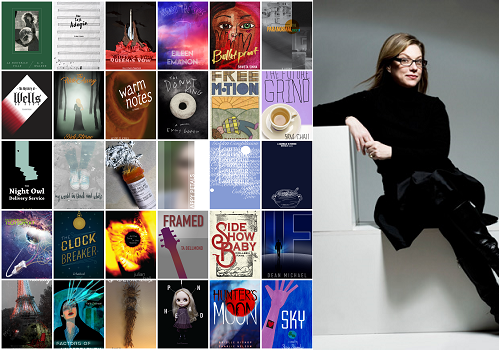
Hello, Wrimos!
If you’ve participated in NaNo before, you might have heard of 30 Covers 30 Days. If you haven’t…do we have a surprise for you! This is going to be bigger than any new binge-worthy Netflix show! And it’s still pretty exciting even if you have heard of it before!
What is 30 Covers, 30 Days?
30 Covers, 30 Days (or 30C30D) is an event that happens every November, in which 30 participants are selected to receive a unique cover for their novel. These covers come courtesy of the talented, professional graphic designers that our amazing 30C30D coordinator, Debbie Millman, has recruited.
Each designer has 96 hours to design a cover, and one of these covers will be posted every day of November on the NaNoWriMo blog, forums, and Instagram!
Some of our past covers can be viewed here.
Maybe now you may be wondering, so how do I submit my novel?
Just fill out this nomination form. You can nominate somebody else’s novel, or your own. It should be noted:
Your real/legal name is not required. If you have a preferred name, pen name, or any other kind of name you would like to use, feel free!Make sure you read over your form carefully, because there’s no way to update the info. If you need to correct something, please submit a Withdrawal Form, and then re-submit your novel.
The submission form will remain open until November 15th. If you don’t quite know what your novel is about yet, don’t worry! Take a week or two to figure it out, and then submit! There’s no priority based on submission date.
If your novel is selected, we’ll get in touch with you for final permissions, and to make sure that all the info is up to date.
Visit the NaNo Artisans Forum! If you want to make a cover, or if you just can’t imagine enduring the suspense of 30C30D, it’s a great place to connect with graphically minded people! Be nice to each other out there!
After you nominate a novel, we know the waiting time is a stressful, but exciting time. And if you decide not to nominate a novel you can still check out the awesome covers and book blurbs by fellow Wrimos.
So what are you waiting for, Wrimos?
Chris Baty's Blog
- Chris Baty's profile
- 63 followers



